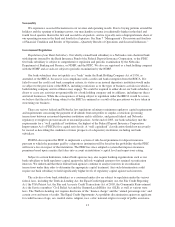Cabela's 2005 Annual Report Download - page 29
Download and view the complete annual report
Please find page 29 of the 2005 Cabela's annual report below. You can navigate through the pages in the report by either clicking on the pages listed below, or by using the keyword search tool below to find specific information within the annual report.• failures to introduce new catalog titles;
• failures to timely fill customer orders;
• changes in consumer preferences, willingness to purchase goods through catalogs or the Internet, weak
economic conditions and economic uncertainty, and unseasonable weather in key geographic markets;
• increases in software filters that may inhibit our ability to market our products through e-mail messages
to our customers and increases in consumer privacy concerns relating to the Internet;
• changes in applicable federal and state regulation, such as the Federal Trade Commission Act, the
Children’s Online Privacy Act, the Fair Credit Reporting Act and the Gramm-Leach-Bliley Act;
• breaches of Internet security; and
• failures in our Internet infrastructure or the failure of systems of third parties, such as telephone or
electric power service, resulting in website downtime, customer care center closures or other problems.
Any one or more of these factors could result in lower-than-expected revenue for our direct business. These
factors could also result in increased costs, increased merchandise returns, slower turning inventories, inventory
write-downs and working capital constraints. Because our direct business accounts for a significant portion of our
total revenue, any performance shortcomings experienced by our direct business would likely have a material
adverse effect on our operating results and cash flows.
Intense competition in the outdoor recreation and casual apparel and footwear markets could reduce
our revenue and profitability.
The outdoor recreation and casual apparel and footwear markets are highly fragmented and competitive. We
compete directly or indirectly with the following categories of companies:
• other specialty retailers that compete with us across a significant portion of our merchandising
categories through direct or retail businesses, such as Bass Pro Shops, Gander Mountain, Orvis, The
Sportsman’s Guide and Sportsman’s Warehouse;
• large-format sporting goods stores and chains, such as The Sports Authority, Dick’s Sporting Goods and
Big 5 Sporting Goods;
• retailers that currently compete with us through retail businesses that may enter the direct business;
• mass merchandisers, warehouse clubs, discount stores and department stores, such as Wal-Mart and
Target; and
• casual outdoor apparel and footwear retailers, such as L.L. Bean, Land’s End and REI.
Many of our competitors have a larger number of stores, and some of them have substantially greater market
presence, name recognition and financial, distribution, marketing and other resources than we have. In addition,
if our competitors reduce their prices, we may have to reduce our prices in order to compete. Furthermore, some
of our competitors have been aggressively building new stores in locations with high concentrations of our direct
business customers. As a result of this competition, we may need to spend more on advertising and promotion.
Some of our mass merchandising competitors, such as Wal-Mart, do not currently compete in many of the
product lines we offer. If these competitors were to begin offering a broader array of competing products, or if
any of the other factors listed above occurred, our revenue could be reduced or our costs could be increased,
resulting in reduced profitability.
We depend on vendors and service providers to operate our business and any disruption of their
supply of products and services could have an adverse impact on our revenue and profitability.
We depend on a number of vendors and service providers to operate our business, including:
• vendors to supply our merchandise in sufficient quantities at competitive prices in a timely manner;
17
























